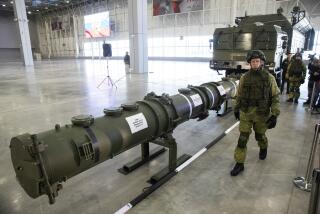Arms Cuts May Not Square the Circle : It’s Hard to Compete With So Much Tied Up in Military R
- Share via
President Reagan found himself juggling two balls last week: arms-control negotiations with the Soviet Union and the question of how to resolve U.S.-Japanese trade frictions. Logically, progress on the one should facilitate progress on the other. Unfortunately, things may not work out that way.
Take first the trade problem.
Foreign manufacturers, paced by the Japanese, have been beating our brains out both here and in world markets. The result is a massive trade imbalance that in 1986 reached almost $60 billion with Japan alone. Some experts believe that the adjustment in the yen-dollar relationship will produce some improvement in the months ahead, but almost nobody thinks that the falling dollar alone will make America competitive again.
The appalling decline in the American ability to compete extends even to such things as high-tech electronic goods, where U.S. supremacy used to be taken for granted but where trade now runs increasingly in the red.
The effect on the U.S. economy of all this has been obscured by the robust employment figures, which reflect the creation of millions of jobs in the service sector. The trouble is that almost half these new jobs pay $7,000 a year or less. Hourly wages as a whole are almost 9% lower now than in 1973. Economists warn that, the way things are going, a long-term decline in the U.S. standard of living may lie ahead.
Japan’s economic strategy, which seeks to maximize exports while carefully regulating foreign access to the Japanese market, is clearly part of the problem. Prime Minister Yasuhiro Nakasone, in his visit to Washington last week, sought to head off retaliatory legislation in Congress by promising remedial measures. We have a right to expect those promises to be kept.
But Nakasone also observed that, when all is said and done, solutions to the U.S. trade crisis do not depend so much on actions by Japan or America’s other trading partners as on Americans themselves. And of course he is right.
The domestic roots of the disastrous decline in the competitiveness of U.S. industry are well known. They include, among other things, corporate managers who focus on short-term profits at the expense of long-term product and market development, and the tradition of confrontation instead of cooperation between labor and management as well as between business and government.
But Congress and the Administration also bear a heavy responsibility for failing to take timely and effective action to control the huge federal budget deficit. The massive borrowings required to make ends meet absorb money that could otherwise go into investment. They also serve to keep interest rates artificially high.
Balancing the budget requires a combination of higher taxes and spending restraints. But Reagan, while insisting that the world situation does not allow cuts in defense spending, refuses to consider tax boosts to pay for the military hardware that he says is necessary. In a perfect world, new arms-control agreements would help square the circle.
Most Western analysts are now convinced that Soviet leader Mikhail S. Gorbachev’s interest in arms control is real, although perhaps temporary, and that it is based on the overriding need to modernize the Soviet economy. He may not envision significant cuts in defense spending, but he apparently is anxious to rule out an expensive new round in the arms race and to shift more of the Soviet Union’s scientific manpower from military to civilian projects.
Although this country has a strong technological lead over the Soviet Union, the U.S. economy could quite clearly benefit from a similar reorientation.
We still spend far more than the Japanese or West Germans do on research and development. But the Pentagon’s share of the nation’s total R&D; effort has soared from 24% in 1981 to 55% now. If the President’s “Star Wars” program were funded in full, the warp would go still higher.
The civilian economy gets a beneficial fallout from government R&D--but; only up to a point. Much of the work is classified. And much of it is directed toward the development of technology that doesn’t translate into civilian products.
Thus a lopsided proportion of our best scientific talent is engaged in defense work, where high cost and technological gold-plating are the rule, while Japan’s best technological brains are busy developing products for the world market. It’s a division of labor that the Japanese find very satisfying.
Robert D. Lohman, former RCA vice president, cited the case of semiconductors in a letter to the Wall Street Journal.
“Military-grade chips bring 10 to 1,000 times the price of mass-produced commercial chips,” he said, “and American manufacturers have gravitated to this lucrative market . . . . Also, a large percentage of our solid-state research-and-development talent is tied up on military projects that may be necessary for defense but do nothing for commercial competitiveness. In Japan the military plays almost no role in the semiconductor industry.”
The United States and the Soviet Union are within reach of an agreement to eliminate intermediate-range and possibly short-range nuclear missiles from Europe; that agreement in turn could ease the way for substantial reductions in the strategic nuclear arsenals on both sides.
The European allies, however, understandably fear that removing these missiles would leave them facing superior conventional, non-nuclear forces on the Soviet side. So the deal may not go through. Even if it does, money saved on nuclear weapons will be needed for expensive, highly sophisticated conventional arms to counter the Soviet advantage.
The Pentagon is now trying to do more to help the economy through spinoffs from government-financed R&D.; But the real need is to make the world safe for the shrinkage of the U.S. and Soviet defense establishments through an across-the-board truce in the big powers’ military and political competition. Realistically, that just isn’t in the cards.
More to Read
Inside the business of entertainment
The Wide Shot brings you news, analysis and insights on everything from streaming wars to production — and what it all means for the future.
You may occasionally receive promotional content from the Los Angeles Times.










